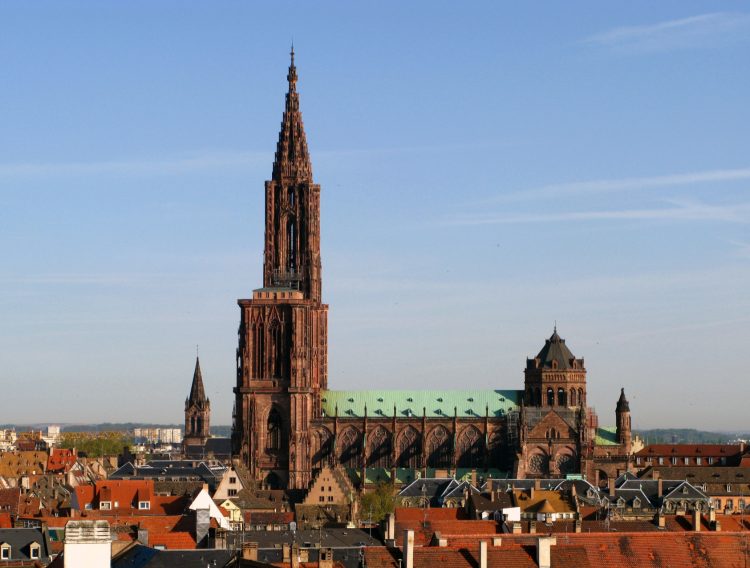The High Gothic Strasbourg Cathedral (Cathédrale Notre Dame) in Alsace, France is a single-tower church with medieval stained-glass windows and an impressive astronomical clock.

Strasbourg Cathedral (Cathédrale Notre Dame de Strasbourg) is a superb example of Late High Gothic architecture and art to make it one of Europe’s greatest churches.. Although only one of its towers was completed, this tower was for centuries the highest man-made construction in the world. The cathedral is in the heart of the UNESCO World Culture Heritage-listed old town of Strasbourg and one of the top sights to see in the Alsace region of France.
Construction History of the Strasbourg Cathedral in Alsace
As with so many other European Gothic churches, Strasbourg Cathedral was constructed on the ruins of its Romanesque predecessor. Fortunately for Strasbourg, the Romanesque church burnt down in 1176, and reconstruction dragged on sufficiently for the bishop to mostly use the newly fashionably Gothic style.
Being able to use the Gothic was quite a coup for the bishopric as it allowed Strasbourg’s new cathedral to outshine darker, Romanesque cathedrals in the region. Bigger, better, and more beautiful than the cathedral in Basel was a clear, and ultimately thoroughly achieved, the goal of the bishop when drawing up plans for the new cathedral in Strasbourg.
Plans for major Gothic churches changed frequently as construction dragged on for centuries during which fashions, and even more importantly, fortunes changed. The lower two stories of the western façade of Strasbourg cathedral was designed by Gothic master-builder Erwin von Steinbach. These parts of the cathedral were completed during the thirteenth century and are clearly of higher artistic merit than the third, which was added during the 14th century.

For Centuries the Highest Church Tower in the World
Strasbourg cathedral famously has only a single tower. Like many other Gothic churches, the money ran out and grandiose plans had to be scaled back.
Strasbourg cathedral’s slender north tower, designed by Ulrich von Ensingen, was completed in 1439. Victor Huge considered the spire the true triumph of the church, while Goethe also famously raved about the High Gothic design of Strasbourg cathedral.
The north tower of Strasbourg cathedral is 144 m (472 ft) high. In 1625, almost two centuries after its completion, Strasbourg cathedral’s spire suddenly became the highest construction in the world after St Olav’s spire in Tallinn burnt to the ground. It held this distinction for almost two and a half centuries until the completion of the Nikolaikirche in Hamburg in 1874.
The High Gothic Exterior of Strasbourg Cathedral, France
The artistic highlight of Strasbourg Cathedral is its wonderful western façade that inspired Goethe. The western façade faces the Place de la Cathédrale, which is lined with historic and half-timbered buildings.
Strasbourg cathedral’s High Gothic façade and the rest of the exterior are full of intricate, lace-like carved stone details, statues, and gargoyles. Despite a spell as a protestant church in the sixteenth and seventeenth centuries, the cathedral lost little of its art.
The main themes of the tympanums are scenes are the childhood and passion of Christ as well as symbols of good and evil. Over the main portal are statues of the wise King Solomon, Christ’s twelve apostles, and twelve lions.
The Interior of Strasbourg Cathedral in France
Strasbourg Cathedral is a typical triple-nave Gothic basilica although the choir and transept still show some Romanesque features from the earlier church. The baptistery by Jodokus Dotzinger and the carved sandstone pulpit by Hans Hammer are 15th-century originals. Also, note the swallow nest for the Silbermann organ high up in the nave.
The true highlight of the Strasbourg Cathedral interior is the magnificent, medieval stained-glass windows. Much of the glass is original although the impressive, 15-m (almost 50-ft) rose window in the western façade is a nineteenth-century copy of the original.
The Astronomical Clock in Strasbourg Cathedral, France
Strasbourg Cathedral houses the famous 18 m (60 ft) high Strasbourg astronomical clock (Horloge Astronomique) in the south transept. The art of the Strasbourg astronomical clock is mostly sixteenth-century Renaissance using some parts from an earlier, fourteenth-century clock. The mechanism itself is from 1842.
The Strasbourg Astronomical Clock plays daily at 12:30 pm. Admission to see the astronomical clock in action starts at 11:20 am – at other times the still clock can be seen for free. Tickets to see the working clock are available from the postcard stand from 9 am.
Strasbourg Cathedral is open daily from 7 am to 7 pm but parts are closed for the astronomical clock display from 11:20 am to 12:40 pm (and during services). Admission to the cathedral itself is free but charged for the astronomical clock and to climb the tower.
Strasbourg Cathedral is the top attraction in Strasbourg but many other sights in the old town are worth seeing. Strasbourg is on the French-German border and several transportation options are available from the rest of Europe. Trains and buses are often the best options and although Strasbourg Airport (SXB) is conveniently located, cheaper flights are usually available to nearby Basel or even Baden-Baden





